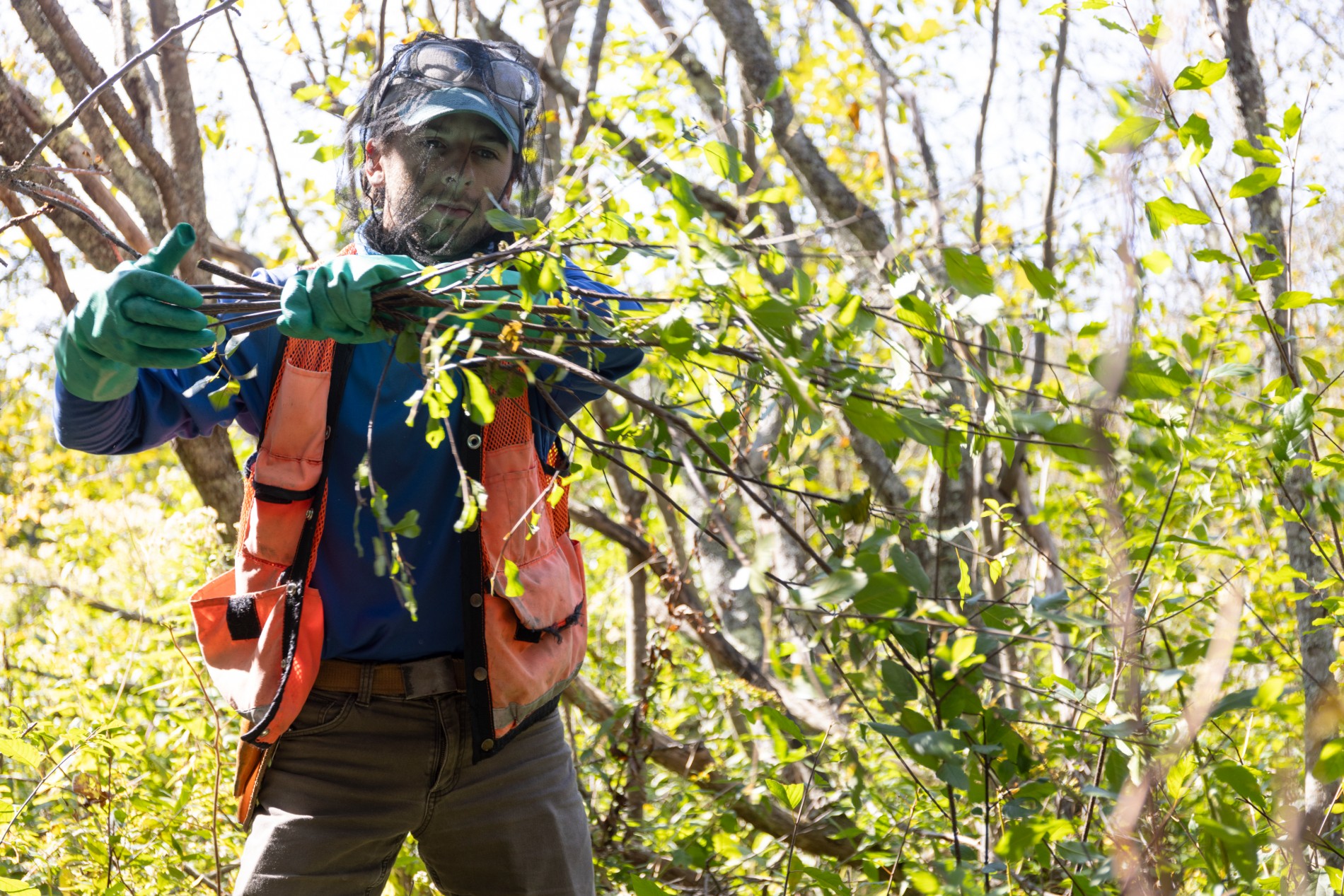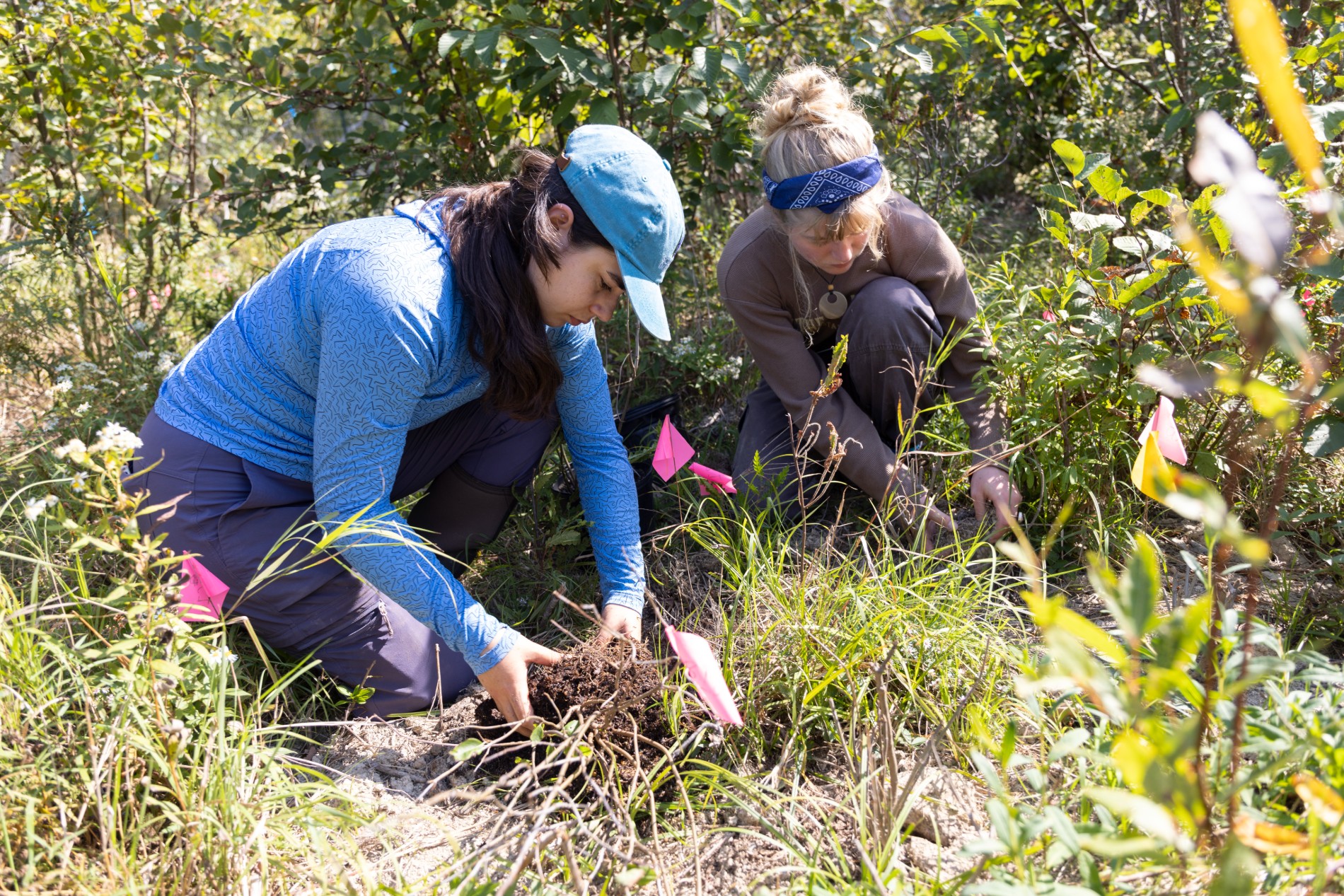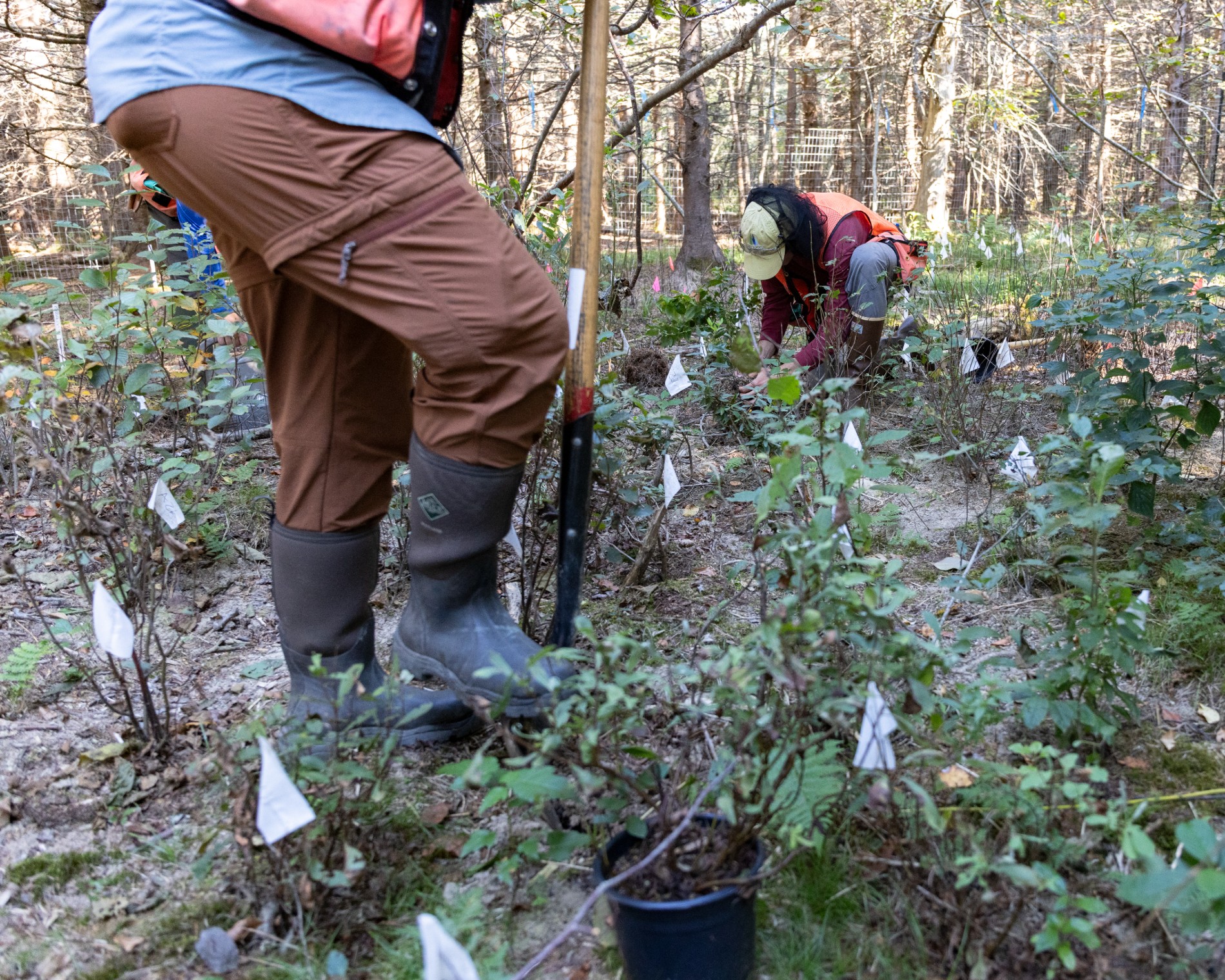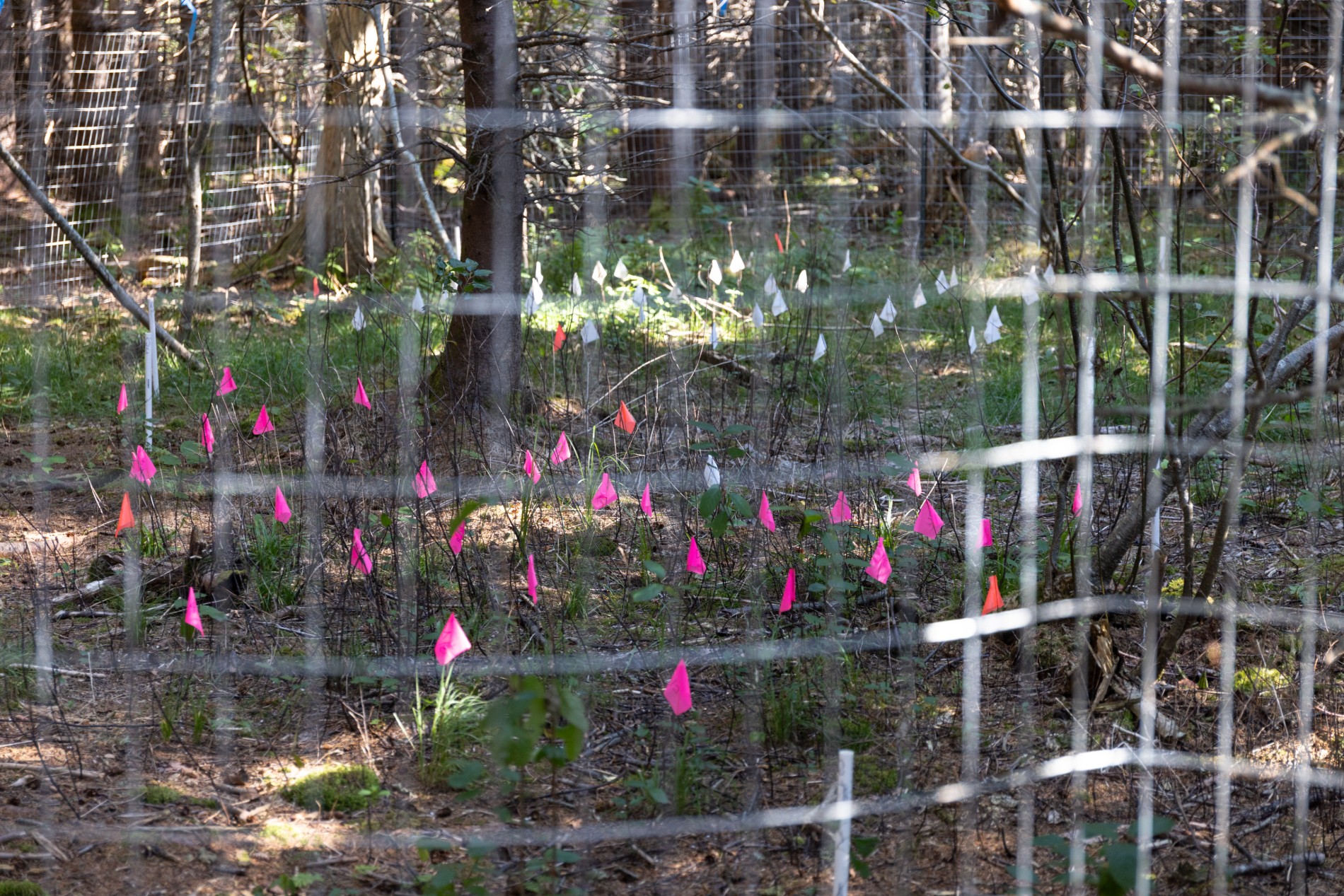Learning How to Crowd Out Invasive Glossy Buckthorn
Experimental plots in Great Meadow and Bass Harbor Marsh are testing the effectiveness of native plants in crowding and shading out glossy buckthorn.
April 2nd, 2025
Experimental plots in Great Meadow and Bass Harbor Marsh are testing the effectiveness of native plants in crowding and shading out glossy buckthorn.
April 2nd, 2025
BY TREVOR GRANDIN
Nestled within the pages of the Mt. Desert Nursery’s 1900 spring catalog is an unsuspecting nuisance.
Between red chokeberry and black jetbead is Rhamnus catharticus—common buckthorn. When George B. Dorr, who would become the first superintendent of Acadia National Park, started the nursery, he could not have known the effort that would be put into removing a once-popular ornamental more than 120 years later.
On today’s landscape, an equally invasive, kindred shrub—glossy buckthorn (Frangula alnus)—weaves its way through Acadia’s forests. Often confused for common buckthorn, glossy buckthorn has taken more tenacious root in Acadia. Clad in dark brown bark, ovular leaves, and white, star-shaped flowers, glossy buckthorn can be found anywhere in the park with moist soil.
Through the partnership of the National Park Service, Friends of Acadia, and Schoodic Institute, research is underway to find the best course of action to manage this widespread invasive.

Devon Jobe, Student Conservation Association member, pulls out invasive plants while spraying pesticides on invasives in Bass Harbor Marsh. (Evie Linantud/Friends of Acadia)
But first, what makes glossy buckthorn so devastating to ecosystems?
Flitting from branch to branch, a cedar waxwing gobbles up the dark purple fruit that hangs in clusters from the surrounding glossy buckthorns. These abundant berries contain a powerful laxative that turns any animal who eats them into buckthorn dispersal mechanisms.
As the bird releases the seed, it lands in a shady marsh. Glossy buckthorn flourishes in full sun but is moderately shade tolerant, enabling it to grow even under canopy cover. Three years later, the stems of this glossy buckthorn have already reached maturity, fruiting much faster than surrounding plants—giving it a head start reproducing.
That rapid maturation is in part due to glossy buckthorn’s prolonged phenology—keeping leaves on later into the fall in relation to its native counterparts. As the glossy buckthorn grows, so too does the shade it casts, making the ground around it inhospitable for many native plants.
The journey taken by this glossy buckthorn is happening time and again throughout Acadia National Park.
Diverse landscapes are transformed into uniform tree stands, and long-practiced mechanical and chemical removal methods can’t keep up with buckthorn’s regrowth. Something has to change.

Schoodic Institute vegetation crew members Amina Wilson and Makenna Haley plot plants in the Great Meadow Acadia National Park. (Evie Linantud/Friends of Acadia)

Schoodic Institute’s Jacob Yosowitz work in the plant plots in Bass Harbor Marsh. (Evie Linantud/Friends of Acadia)
During the 2023 field season, Acadia National Park’s vegetation crew spent 660 person hours, or a little over two months, treating and surveying this single invasive species. How can one address this invasive plant while freeing up the valuable time and energy of park managers?
Throughout Great Meadow and Bass Harbor Marsh, 21 experimental plots are trying to answer that question.
These 10-by-10-meter tracts are testing the effectiveness of native plants in crowding and shading out glossy buckthorn. Planted within the plots are a variety of native grasses, sedges, rushes, and shrubs.
Led by Schoodic Institute Climate Adaptation Scientist Dr. Chris Nadeau, technicians track the growth of both the native plants and the surrounding glossy buckthorn throughout the year. They note information like shade percentage and germination rate—data that could uncover which native plants might outpace or slow down the growth of glossy buckthorn.
Two years of data have been collected, and although the project is ongoing, the numbers seem promising.
“More than 1,500 native plants have been restored through the experiment with a survival rate of 89%,” said Nadeau. “Planting native shrubs in particular has reduced buckthorn reinvasion by up to 41% and reduced germination of buckthorn seeds by up to 56%. Some native shrubs in particular show promise at slowing down glossy buckthorn germination, like speckled alder (Alnus incana) and black chokeberry (Aronia melanocarpa).”
It’s an encouraging start to an experiment that allows scientists and managers to “learn while doing.”

Flags mark plant plots in Bass Harbor Marsh. (Evie Linantud/Friends of Acadia)
Another potential tool for Acadia’s glossy buckthorn management toolbox is “critical period cutting.”
Starting in late spring, researchers cut taller buckthorn shrubs at chest height and strip the main stems of any growth. They then come back multiple times a year to strip the tree again. The cycle of stripping the stem bare continues until the tree dies.
Starting in 2024, Schoodic Institute researchers tested this approach on two private partner properties. Glossy buckthorn stems were randomly assigned pruning frequency treatments—every one, two, or three months. With only one growing season on the books, preliminary results show little mortality but suggest that a higher
cutting frequency correlates to lower regrowth.
Both the native plant plot and critical period cutting experiments are in their early stages and need more data to illustrate emerging trends, but the possibility of their success gives hope to a rapidly changing landscape. Glossy and common buckthorn were once sold in nurseries across Maine, but clicking through a nursery catalog today, you would be hard pressed to find either for sale—they are illegal to sell, propagate, or trade in Maine—helping reduce their resurgence in residential backyards and places like Acadia National Park.
Learn more: Expanding the Management Toolbox for Glossy Buckthorn in Acadia – via Schoodic Institute
TREVOR GRANDIN was a Cathy and Jim Gero Acadia Early-Career Fellow at Schoodic Insitute for the 2024 season.
The success of Acadia’s 35-plus-year invasive plant management program is a testament to commitment and collaboration.
Learn More